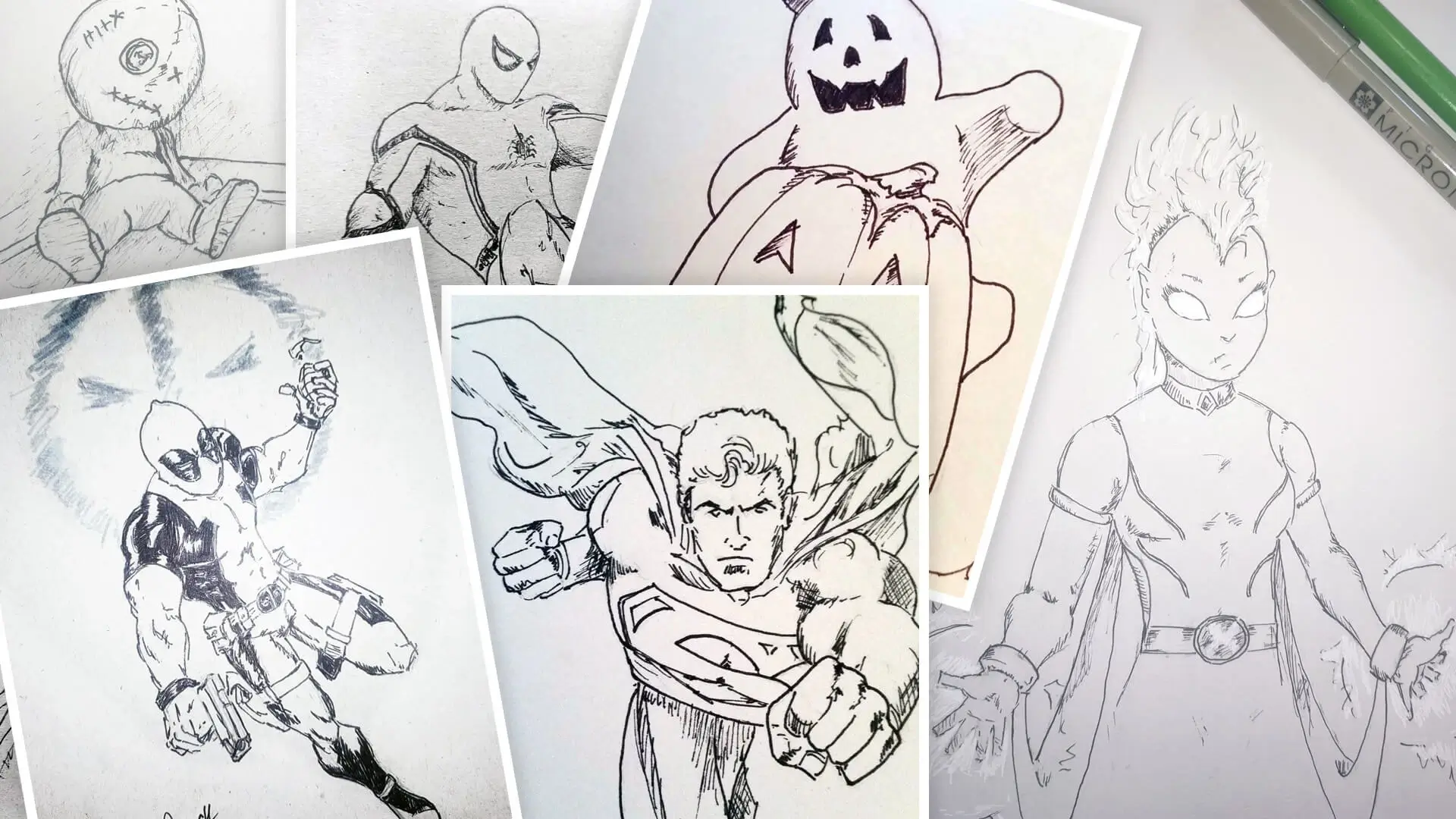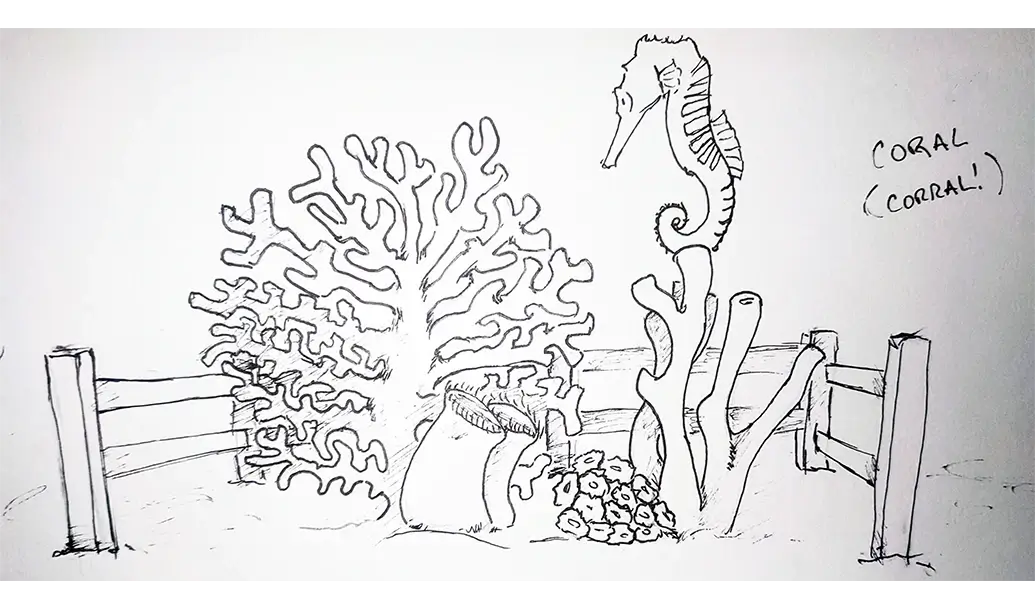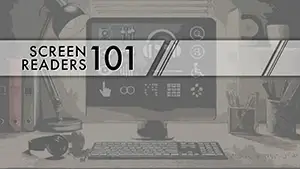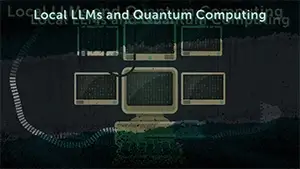
Image credit: Original image
Do you enjoy creating for the sake of creating? Me too. There's something special about putting pen to paper. Each stroke is thoughtful, deliberate, and carries a sense of permanence. Unlike my typical tools of a code editor, Photoshop, and a web browser (or digital creations), where every mistake can be erased with a click, creating in ink demands commitment. For those of us who love to doodle in the margins of meeting notes or on the back of napkins, our art embodies a balance between control and chaos. Inktober* has captured and shared this blend with the world.
The Origins of Inktober
To understand Inktober, we first need to appreciate where it all began. Inktober wasn't born in a boardroom or conjured up by a marketing team. The story starts with an artist named Jake Parker back in 2009. As a professional illustrator, Jake found himself looking for a way to improve his inking skills and to develop a habit of daily drawing. He set a personal challenge to draw with ink every day for an entire month. What began as a solo journey quickly grew into something much bigger.
By sharing his progress online, Jake inadvertently created a global movement that encouraged artists of all skill levels to participate in the challenge. The name Inktober was born, blending the medium of ink with the month of October. One man's journey of self-improvement has grown into a worldwide community, with hundreds of thousands of artists coming together each year to celebrate their craft.

The Simplicity and Complexity of Inktober
The concept is deceptively simple and involves creating one ink-based drawing every day in October. No fancy tools are required, just ink, paper, and your imagination. This simplicity is what makes Inktober accessible to anyone—whether you're a professional illustrator or someone who just loves to doodle.
But beneath that simplicity lies a certain level of complexity. Committing to 31 days of daily art is no small feat. There's a discipline required to sit down, create, and share something consistently. For those of us who are juggling client meetings, deadlines, and project deliverables, carving out the time to draw each day can feel like an impossible task. Yet, this very constraint is where the beauty of Inktober shines through. If just for a few minutes each day, it forces you to prioritize your creative outlet.
Because of this commitment, a lot of people have taken it a bit more loosely to celebrate the month as a whole and draw as often as they are able.
Structure in Creativity
While Inktober encourages spontaneity, it does come with a few guidelines that provide structure for participants. The rules are simple:
- Make a drawing in ink (you can start with pencil as a guide).
- Post it online.
- Use the hashtags #Inktober and #Inktober2024 (current year).
- Repeat daily throughout October.
The rules act as a gentle framework rather than rigid directives. You're free to interpret them in a way that works for you. Some artists prefer to follow the official daily prompts provided by Inktober, which are one-word suggestions meant to spark creativity. Others choose to create their own themes or simply draw what comes to mind each day.
For those of us who seem to thrive on the blend of structure and freedom, this combination can be incredibly liberating. Having a daily prompt reduces the decision fatigue that can sometimes come with the process of creating, while the freedom to interpret those prompts keeps the challenge fresh.

Tools of the Trade
One of the key appeals of Inktober is its emphasis on traditional media. In a world increasingly dominated by digital tools, Inktober serves as a reminder of the tactile satisfaction of ink on paper. There's something grounding about holding a physical pen and watching as ink flows onto the page.
That being said, there's no one right way to participate in Inktober. Some artists stick to the most basic tools: a black ink pen and a sketchbook. Others get more experimental, incorporating brush pens, nibs, and washes into their work. The challenge is designed to accommodate a range of skill levels, so whether you're using an old ballpoint pen or a professional-grade fountain pen, the spirit of Inktober remains the same.
Personally, I've always found a certain charm in the simplicity of ink, though admittedly I often start with a pencil sketch to build from. As someone who spends much of my day managing digital workflows, going analog can be an escape, even if just for a few minutes each day. If you're one who starts with ink, it forces you to commit to each line. There's no undo button, and each mark becomes part of the narrative of the piece.
Beyond Just Drawing
For many, Inktober is a chance to step out of their comfort zone, experiment, and develop a consistent creative habit. The daily practice of drawing sharpens observational skills, improves hand-eye coordination, and encourages you to think more critically about composition and form.
Beyond the technical benefits, there's an emotional component to Inktober as well. The act of creating something every day, no matter how small, can create a sense of accomplishment. Even on days when life feels chaotic, those few moments spent inking can serve as a grounding force. It's a reminder that creativity doesn't have to be grand or perfect; it just needs to be present.
It's a chance to create something purely for yourself, without the pressure of deadlines or approval processes. This freedom to experiment is invaluable and can often lead to breakthroughs in other areas of your work.
Community and Connection
One of the most rewarding aspects of Inktober is the community it fosters. In a time where social media can feel increasingly isolating, Inktober is a reminder of the positive potential of online platforms. Artists from around the world come together to share their progress, offer encouragement, and celebrate each other's achievements.
Scrolling through the #Inktober hashtag is like a virtual art gallery. You'll find everything from highly detailed illustrations to playful, minimalist sketches. There's no judgment, only appreciation for the act of creation. For those of us who work in industries where feedback can sometimes feel like a battleground, this supportive environment is a breath of fresh air.
And for those of us who love to tinker with both the creative and technical sides of our brains, Inktober's blend of analog and digital is particularly appealing. While the artwork is created by hand, sharing it online connects you with a global audience. It's a beautiful intersection of the old and new, reminding us that art can be both personal and communal.
To be fair, some have even begun to include digital drawings vs ink as their goal for the month of October. Creating digital drawings is a challenge all its own and a skill that is no less valid.
The Evolution of Inktober
Since its inception in 2009, Inktober has evolved in many ways. What began as a small, personal challenge has grown into a global phenomenon, with artists from all over the world participating each October. The challenge has expanded beyond ink drawings, with many artists experimenting with mixed media, digital art, and more.
In recent years, Inktober has also sparked discussions around copyright and ownership, leading to some controversy within the artist community. However, the heart of Inktober remains unchanged—it's about challenging yourself to create, experiment, and improve your skills over the course of a month.
For me, Inktober is a time to step away from the daily grind and rediscover the joy of drawing. Inktober serves as a reminder that creativity doesn't have to be complicated. It just has to be practiced.
Why Inktober Matters
In a fast-paced, deadline-driven world, Inktober offers a moment of pause. It's an invitation to slow down, pick up a pen, and make something tangible. Regardless of your skill level, Inktober is a chance to embrace creativity in its simplest form.
For those of us working in creative industries, it's easy to get caught up in the technical precision and perfectionism that our jobs often demand. Inktober reminds us that art doesn't have to be perfect to be meaningful. Sometimes, the most powerful creations come from a place of spontaneity and imperfection.
So, as October approaches, I encourage you to join the Inktober challenge. Grab your pen, find a quiet corner, and see what happens when you let your creativity take the lead. You might just surprise yourself.
*The name Inktober and it's logo mark are trademarked J.P. Creative, LLC (“J.P. Creative”)


